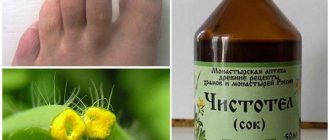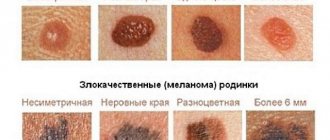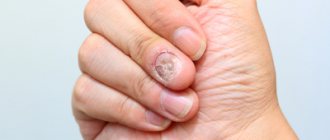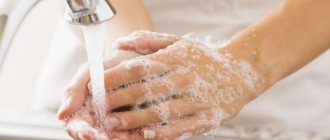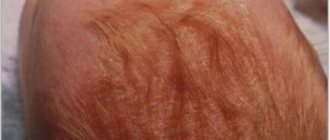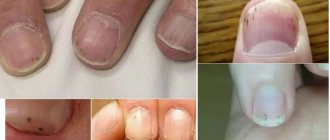In this article, you will learn what hyperkeratosis of the fingernails and toenails is and how to treat it.
Appearance is of great importance to each of us. The general impression of a person is formed based on his clothes and well-groomed hands. Therefore, if a person has a disease that spoils his appearance, this makes him think about effective and immediate treatment. Nail hyperkeratosis is an unpleasant disease that causes a lot of trouble for a person. In this article we will look at the causes of this pathology and methods of treating it.
Hyperkeratosis of fingernails and toenails - causes, signs, forms, photos
Hyperkeratosis is a serious fungal disease in which the nail plates and skin areas become covered with an excess of growing cells. The process of exfoliation of dying cells is disrupted, and the growth of the stratum corneum increases. Fingers, toes, feet, palms and elbows may be affected. There is hyperkeratosis progressing in the lip area.
Causes of hyperkeratosis of fingernails and toenails:
- Progressive skin diseases.
- Pathologies and diseases of the endocrine system.
- Metabolic disorders and excess weight.
- Stress and psychological disorders.
- Excess or lack of vitamins.
It should be noted that the trigger for the development of the disease is largely external factors:
- Increased load on the lower limbs.
- Unsuitable area of activity: working with detergents, frequent exposure of hands to highly hard water, use of poorly breathable gloves.
The manifestation of hyperkeratosis of the toenails may indicate poor hygiene care and incorrectly selected shoes. The disease should not be excluded as a consequence of the presence of vascular pathologies and a sign of excess weight.
The forms of hyperkeratosis can be different:
- The development of the disease begins with the initial form, when the yellowness of the nails only appears.
- At the next stage, the nail begins to thicken and its aesthetic appearance deteriorates.
- The deep form of hyperkeratosis can penetrate under the nail area. This occurs due to the proliferation of filamentous fungi. This is the most complex form of hyperkeratosis, which requires long-term treatment.
Signs of the disease:
- First, yellowing of the nail occurs, and then thickening of the nail plate.
- The structure of the nail changes, becoming denser or becoming loose.
- The nail changes color.
- The fragility of the nail plate increases.
Nails are a mirror of the health of the entire body, so they require increased attention and are demanding in caring for. It is important not to start the disease, and to begin immediate treatment at the initial stage of the disease.
Thickening of nails
Fungus
Diabetes
25447 October 27
IMPORTANT!
The information in this section cannot be used for self-diagnosis and self-treatment.
In case of pain or other exacerbation of the disease, diagnostic tests should be prescribed only by the attending physician. To make a diagnosis and properly prescribe treatment, you should contact your doctor. Thickening of nails: causes, diagnosis and treatment methods.
Description
Beautiful and well-groomed nails, skin, hair and teeth are the main external indicators of human health. One of the common symptoms of nail damage is thickening of the nails. Many people neglect this symptom, although such changes in the nails bring significant discomfort: the nail plate becomes layered, brittle and repulsive in appearance.
Normally, nails are no more than 1 mm thick, have a pinkish tint, and a smooth and shiny surface.
Types of thickening of nails
Depending on the cause of thickening of nails, two types can be distinguished:
- Hereditary thickening of the nails, which appear from early childhood and are difficult to correct.
- Acquired thickening of the nails, which occurs during the development of various diseases or as a result of external influences.
Causes of thickening nails
- Fungal diseases of the nails (onychomycosis)
are the most common cause of thickening of the nail plate. Depending on the type of fungus and its ability to destroy the structure of the nail, the localization of the fungus varies. The most favorable place for fungal growth is the area at the junction of the nail plate and the nail bed, that is, on the side of the nail near the skin folds. The introduction of fungi is facilitated by injuries to the nail and surrounding skin (burrs, scratches, etc.).
The main symptoms of the presence of nail fungus:
- thickening of the nail;
- change in nail color or transparency;
- nail destruction (foliation, crumbling, thinning of the nail plate);
- subungual hyperkeratosis (increased cell division of the stratum corneum of the epidermis);
- inflammation of surrounding tissues (redness, swelling, soreness).
Nail fungus is a contagious disease that requires timely treatment.
Risk factors for fungal infection include:
- endocrine diseases (diabetes mellitus);
- vascular diseases;
- flat feet;
- use of shoes, gloves and towels of a person with onychomycosis;
- frostbite;
- excessive sweating of the skin of the extremities or, conversely, dryness.
- Psoriasis
is a chronic autoimmune disease of the skin and nails that can develop at any age. Nail changes occur in 30% of psoriasis cases and are characterized by a yellow-brown color of the nail plate or the appearance of spots of the same color (resembling oil stains). A ribbed surface of the nail is formed due to its crumbling, areas of thickening, alternating with areas of onycholysis (small depressions and separation of the nail plate from the bed). Damage to the nails can be combined with lesions of the skin, which manifests itself in the form of pink plaques of different shades with clear contours, covered with scales. - Circulatory disorders of the lower extremities
leads to a decrease in the flow of nutrients and oxygen to the tissues of the fingertips. Under hypoxic conditions, normal cell growth is disrupted and conditions are created for abnormal thickening of the nail plate.The group of diseases that lead to impaired blood circulation in the tissues of the lower extremities includes atherosclerosis and chronic venous insufficiency.
Atherosclerosis is a chronic, slowly progressive disease, manifested by focal thickening of the inner layer of arteries due to lipid deposition and reactive proliferation of connective tissue.
Chronic venous insufficiency, which also manifests itself as varicose veins of the lower extremities, is one of the most common causes of thickening of toenails.
- Thickened nails with a “watch glass” appearance are characteristic of some cardiovascular diseases and chronic lung diseases.
The nail plate thickens and is somewhat rounded around the finger. This occurs due to a decrease in oxygen levels in the blood and tissues over several years, so a person may not notice the changes at first.
- Injuries
to the nail plate and surrounding tissues are fraught with disruption of the normal processes of nail growth and often their thickening, as well as changes in the color of the nail plate. - Thickening of the nails may be a consequence of inflammatory lesions of the nail and surrounding tissues
. If the nail matrix area is damaged, the normal processes of growth and formation of the nail plate are disrupted. Changes can occur either towards thickening or thinning. - Diabetes
characterized by sensorimotor neuropathy and circulatory disorders in the distal (extreme) parts of the extremities. Areas of hypoxia form, which lead to the formation of zones of hyperkeratosis and thickening of the nails. As a result of impaired sensitivity of the lower extremities, a person does not notice minor injuries.Incorrectly selected
shoes
change the normal position of the foot and toes, which leads to compression and poor circulation of the nail plate and surrounding tissues.
Tissue hypoxia is formed, which, in addition to ulcerative defects (diabetic foot), leads to excessive collagen formation and thickening of the nails. - Congenital pachyonychia
is a rare condition that is characterized by thickening of the nails and skin of the plantar part of the foot due to a disruption in the process of keratin formation due to mutations in the genes encoding the formation of the keratin-16 protein. Thickening of the nails occurs, which manifests itself already in childhood. Large calluses form on the skin, causing pain.
You can often find descriptions of thickening and curvature of the nail like the claw of the mythical griffin bird. Such a change is called onychogryphosis
and is characterized by changes in the periungual tissues, hypertrophy of the horny plates, their compaction and twisting. It is a fairly rare dystrophic lesion of the nail plate.
Which doctors should I consult if my nails are thickened?
If the problem of thickening of the nails persists for a long time and is not associated with a nail injury, and there are other pathological symptoms, then you should not go to a nail service specialist to correct the appearance of the nail, but you should contact a therapist to find out the possible cause of the symptoms. Consultation with other specialized specialists may be required: rheumatologist, vascular surgeon, cardiologist, endocrinologist.
Self-diagnosis and self-medication in this situation can lead not only to loss of nail beauty, but also to more serious problems.
Diagnostics and examination for thickening of nails
After an initial examination, the doctor may prescribe a set of laboratory and instrumental diagnostic methods to establish the causes of symptoms and clarify the diagnosis.
- Microscopy and culture for parasitic fungi from the nail plates.
Hyperkeratosis of toenails and fingernails: how to treat?
Nail Hyperkeratosis
Hyperkeratosis is a type of fungus that appears due to the rapid proliferation of skin cells. The disease on the fingernails and toenails manifests itself as keratinization of the layer of skin under the nail plate. Hyperkeratosis is expressed in an increase in the nail layer, its delamination, changes and deformation of the nail plate.
To treat hyperkeratosis of fingernails and toenails:
- Tablets are used in conjunction with various ointments and gels, as well as medicinal nail polishes - Fluconazole, Ketoconazole, Nizoral .
- Antifungal tablets, where the main active ingredient is group Amphotericin .
- The use of ointments and gels is necessary to relieve itching and reduce the burning sensation - Lamisil, Batrafen, Neilexpert . The cream, penetrating deep into the nail plate, kills the fungus and, nourishing the skin around it, prevents the disease from spreading further.
- To treat the disease, in the initial stages you should use special varnishes that destroy pathogens - Loceryl, Demicten .
- An antifungal spray is used to treat the foot and interdigital space - Mikozan .
Most often, to treat hyperkeratosis, dermatologists prescribe antifungal gels to their patients with the active ingredient Naftifine , which is aimed at improving the effect of tablets and capsules. Only such comprehensive treatment will help and get rid of the fungus.
Advice: The drug Fluconazole helps get rid of the fungus very well. But you need to drink it within six months. Only a doctor should prescribe the dosage. Self-medication is dangerous to health, as this drug can negatively affect liver function.
Naturally, do not forget that it is the complex and the system that are the best that can defeat the disease. Drink the medicine systematically, at certain times of the day, and also use varnishes, sprays and ointments to treat the nail plate.
Treatment of foot hyperkeratosis
Hyperkeratosis of the foot is an abnormal thickening of the epidermis around the foot, often accompanied by keratinization of skin cells. This condition is considered a cosmetic defect and is not generally considered a health hazard. Although this point of view cannot be said to be completely wrong, it should be assumed that the condition of the skin directly depends on the health of the body. Sometimes cosmetic defects are only minor manifestations of hidden complex diseases.
content
External reason
Horned feet
The cause of excessive development of keratosis of the feet is various excessive loads on the foot. Prolonged high pressure activates the proliferation of gametes in the epidermis, as part of the upper layer of skin “wears away” due to the upper effect. However, due to pressure and faster division of epidermal cells, the top layer of skin peels off too late. The combined effect of these factors is an abnormal thickening of the dermis, which not only looks unsightly, but also makes shoes uncomfortable.
Improper footwear is often the cause of excessive keratosis of the foot. Beautiful but comfortable shoes, shoes with narrow toes, or vice versa, shoes that are worn for a long time can cause pathological changes in the foot. Choosing the wrong shoes can make you lose the ability to wear shoes after a while. However, “regular” shoes can also become unusable due to bunions and other defects.
Flat feet, deformed feet, foot injuries from surgery or accidents, and weight gain can cause hyperkeratosis. Any of these defects can cause disease because the damage will change the force applied to different parts of the foot. As a result, the pressure on the skin decreases in some places and increases in others.
Cell regeneration is activated after an individual “critical point” with continuous exposure to the skin. The natural result is an abnormal change in the upper layer of the epidermis.
Internal reason
Heel peeling for psoriasis
Excessive keratosis of the foot can be caused not only by external, but also by internal factors. Some of them are very dangerous for the body. Among them, it is worth highlighting diabetes mellitus, because one of the manifestations of the disease is metabolic disorders. Carbohydrate metabolism is especially important for the body. This disrupts tissue nutrition and increases the risk of a number of skin diseases. Including hyperkeratosis of the feet and conditions that can cause it: ulcerative lesions, dry skin, death of skin cells due to problems with blood microcirculation in the capillaries. Especially if the patient wears uncomfortable shoes, they can put a lot of pressure on the feet and worsen the condition due to excess weight.
Skin diseases, regardless of their course and severity, often become a catalyst for the development of the disease. Hyperkeratosis may occur after or simultaneously with:
- psoriasis;
- Ichthyosis;
- Keratosis of the palms and soles;
- Fungus and other skin lesions.
Usually, several factors act simultaneously, so the risk of hyperkeratosis is high and the degenerative process of the epidermis is accelerated.
Even the wrong course of pedicure can cause the onset of a degenerative process. However, this procedure will not be the culprit of the disease - it will only become a catalyst for the degradation process, and the prerequisites for the degradation process in the body were created long ago.
Soften and cut
Peeling stage
Hyperkeratosis of the foot is a disease that podiatrists encounter at work. When the disease is in the active phase, you should first consult a doctor. Choose an effective treatment according to its complexity and the cause of abnormally active epidermal cell division. Usually collected once, they effectively fight the disease for many years.
An effective standard of treatment for foot hyperkeratosis includes several mandatory measures to eliminate cosmetic defects of the disease. The keratinized area of skin is always exposed, its purpose is to soften the hard dead layer. This will allow them to be painlessly brought into the “living” layer of the epidermis. Depending on the duration of the disease and the degree of negligence, the intensity of the operation may vary. However, the result is the same keratinized area of skin, independently or completely cut off by the doctor’s hand.
The final stage is skin rejuvenation in the foot treatment area. To do this, you can use special accessories for medical manipulators or ordinary cosmetic files. It all depends on the degree and intensity of the required impact.
Experienced doctors will be able to remove dead tissue and release “living” skin without causing any harm to it. But basically it depends not only on the qualifications of the doctor, but also on the stage of development of hyperkeratosis and the “emollients” used.
Other Treatment Options
Therapeutic pedicure “before and after”
In case of an advanced form of the disease, instead of self-medication, you should seek help from a specialist. From these methods he will choose the best one.
- Use of a keratolytic agent. A classic treatment plan involving softening of the keratin tissue and subsequent cleansing. Careful selection and concentration of active ingredients is required. For example, when treating hyperkeratosis with a 10% urea solution, the hardened tissue will be “beneficially” softened. A 40% solution dissolves the nail plate.
- Medical pedicure. Used as a cosmetic method to eliminate defects in early hyperkeratosis. If the cause is not eliminated, the operation will not have a therapeutic effect.
- Sterilization treatment.
- Photodynamic antimicrobial therapy. Treatment of forms of complications with ulcerative lesions and deep hardened cracks.
- Use of orthopedic equipment. They cannot eliminate the cosmetic defects of hyperkeratosis, but by removing the keratinized area of skin, they can maximally prevent or delay relapse.
Softening and peeling of keratinized tissue is not the only way to combat foot hyperkeratosis; it is now used in medicine. Pathology can be caused by various reasons and can be aggravated by a late visit to an orthopedist.
Allergic hyperkeratosis of nails: symptoms, causes, treatment
Allergic hyperkeratosis of nails
Hyperkeratosis is a series of dermatological diseases in which there is an excessive increase in the stratum corneum of the skin. Fungal infection of the nails causes subungual hyperkeratosis. The nail plate begins to thicken, which brings a lot of inconvenience, pain and discomfort.
The main causes of allergic hyperkeratosis of the nails include:
- Dysfunction of the immune system.
- Complication from psoriasis.
- Severe stress
- Chronic eczema
- Intestinal tract disorder
- Excess of vitamins
- Diabetes
- Acute viral infections
Important to know: For effective treatment, it is important to diagnose this type of hyperkeratosis in time and make the correct diagnosis. Therefore, if you have any health problems, consult a doctor.
The main symptoms of allergic hyperkeratosis:
- Weakening of the nail plate
- Changing nail color
- Plate delamination
- Nail deformation
- Sealing of the nail plate
Treatment of allergic hyperkeratosis must begin immediately, because over time the disease will progress and can spread throughout the body. When the diagnosis is made, the doctor prescribes:
- Complex treatment using various antifungal drugs, both for external use (sprays, ointments, varnishes) and internal (tablets). See above for a description of what medications can be used to treat this disease.
- Antihistamines are prescribed for allergies Zodak, Dezal, Suprastinex and so on.
As mentioned above, it is necessary to take medications until a healthy nail grows. The standard course of treatment for subungual hyperkeratosis is from two to six months.
Types of hyperkeratosis and causes of its appearance
Depending on the origin, the disease is divided into acquired and hereditary. Based on the nature of the manifestation, the following forms of hyperkeratosis are distinguished:
- follicular;
- seborrheic;
- diffuse;
- lenticular;
- warty;
- disseminated;
- polymorphic;
- hyperkeratosis of the feet.
External factors for the development of hyperkeratosis include wearing tight and constricting clothing and shoes, frequent contact with chemicals (professional costs), and failure to comply with personal hygiene rules. Internal causes of hyperkeratosis include various skin diseases, including:
- ichthyosis;
- seborrheic dermatitis;
- lichen;
- psoriasis;
- foot fungus;
- disruption of keratin production;
- keratoderma.
Some causes of the disease include endocrine diseases, including diabetes mellitus, excess body weight, vitamin deficiency and erythroderma.
Hyperkeratosis of the nail cuticle: treatment
Hyperkeratosis of the nail cuticle
Hyperkeratosis accounts for about 20% of all skin and nail diseases. The nail cuticle serves as protection for the nail from various pathogenic pathogens. However, with unprofessional manicure or poor hand care, the cuticle is damaged and becomes an entry point for infection. The affected cuticle is characterized by growth, redness, and the appearance of painful cracks. If left untreated, the infection quickly spreads to the nail plate.
In most cases, the occurrence of hyperkeratosis is associated with a fungal infection. However, manifestations of hyperkeratosis are possible with the following pathologies:
- Psoriasis
- Eczema
- Lichen planus and other systemic diseases
In any case, the trigger for the disease is a weakened immune system. Treatment of hyperkeratosis can only be comprehensive, under the supervision of a podiatrist or dermatologist . If the fungal nature of the disease is confirmed (by culture), therapy includes antifungal drugs. The following tablets are used:
- Pimafucin
- Nystatin
- Levorin
- Fungizon
- Fungicidal creams and ointments
Products that need to be applied to the affected areas soften the skin around the nail and eliminate discomfort. The duration of treatment depends on how far the disease process has progressed. Skin manifestations are cured relatively quickly, but if the infection has taken over the nail, long-term and persistent therapy will be required - up to 6 months .
How to treat nail psoriasis?
Psoriatic changes make the nails look scary. This causes worries, fears, and complexes, especially in women. I want to hide and not show my hands to anyone, it’s awkward to leave the house, and I constantly feel embarrassed. Those around you immediately believe that it is something contagious and instinctively step aside. Although in fact the disease is not contagious, it is not transmitted from one person to another, even through close contact.
Nail psoriasis causes serious psychosocial and cosmetic problems. Therefore, the main goal of treatment is to improve the appearance of hands. It will take time to notice positive changes. This is due to the slow growth of the nail plate and the cumulative effect of the drugs used.
Medicines include systemic and local agents. For each person, the doctor selects them individually, taking into account the symptoms and severity of the condition. Sometimes you have to try different treatment regimens to achieve results. Reviews on nail psoriasis forums from patients confirm this fact.
In addition to medications, a course of phototherapy or insolation is sometimes prescribed. Impact on the affected areas of the skin and nails helps stop excessive cell division and plaque formation, relieve inflammation and itching.
In case of severe damage, when restoration of the nail plate is impossible, it is removed. Subsequent therapy is aimed at growing a new healthy nail. Vitamins help speed up growth. They are prescribed internally and externally in the form of oil solutions (Aevit) to treat the skin of the finger, nail bed, and growing plate.
Any medications are used only under the supervision of a dermatologist, carefully following the doctor's instructions. Self-medication of psoriasis can aggravate the disease, prolong the course of therapy, and create serious complications.
Systemic drugs
If necessary, systemic medications are prescribed by a dermatologist.
These are the same remedies that are used for psoriatic skin rashes:
- Cyclosporine. Refers to immunosuppressants or drugs that suppress the activity of the immune system. Stops the formation of new psoriatic plaques and reduces the size of existing ones. It is mainly used only for severe forms of psoriasis;
- Methotrexate. Affects metabolism inside cells, blocks the vitamin activity of folic acid. In psoriasis, it exhibits an immunosuppressive effect, suppressing the pathological autoimmune reaction;
- Retinoids. These are synthetic analogs of vitamin A that affect immune cells and normalize the reproduction and development of keratinocytes. Suitable for long-term use;
- Wobenzym. An enzyme preparation that helps relieve the unpleasant symptoms of psoriasis during exacerbation. Relieves inflammation and swelling. It has a general strengthening effect, prevents relapses and further deterioration.
Self-medication with the listed drugs is unacceptable, as there are contraindications and dangerous side effects.
Local remedies
Local remedies for nail psoriasis include:
- Ointments based on medical solid oil (Kartalin, Magnipsor, solid oil ointment). They have an anti-inflammatory, regenerating, exfoliating effect;
- Hormonal ointments with corticosteroids. They are first-line drugs to relieve symptoms. Relieves inflammation, pain, redness. Improves the condition of the nail bed and matrix;
- Creams Calcipotriol, Daivonex. Contains a synthetic analogue of vitamin D. Regulates immune processes in the skin, slows down the accelerated division of cells in the stratum corneum. Particularly effective for subungual hyperkeratosis;
- Ointments with retinoids (Zorak, Tazarotene). Exfoliate inflamed, damaged epidermal cells, smooth the surface of the skin. They help with psoriatic dystrophy affecting the nail bed and matrix, but the therapeutic effect develops slowly;
- Keratolytic varnishes, gels with urea. Exfoliate, smooth the surface of the nail plate, nourish.
Folk remedies
Folk remedies are also used to treat nail psoriasis at home. In agreement with the doctor, they are used as an addition to the main medications.
Baths, compresses, lotions with decoctions of medicinal herbs that have an antiseptic and healing effect help. These include bay leaf, sage, oak bark, chamomile, and celandine.
Hyperkeratosis under the fingernails and toenails: treatment of subungual hyperkeratosis, photo
Hyperkeratosis under the fingernails and toenails, in most cases, is the result of a fungal infection of the skin or nail beds. During its life, the harmful fungus causes changes in cell connections that form new surface layers. Nail separation, change in color, thickening are consequences of mycosis.
Treatment of subungual hyperkeratosis requires strict discipline. The sooner therapy is started, the faster a person can get rid of unattractive symptoms. This is what this treatment consists of:
Horny nail tissue affected by fungus must be removed.
- This can be done using nail scissors, special tongs, or a nail file.
- There is no need to damage healthy areas.
- Hygiene items that come into contact with the infected area must be disinfected each time after and before use.
- If, as the horn plate grows, new changed areas appear, they should also be removed and health procedures should be continued.
Application of medications.
- Pharmacological agents are applied in the form of drops to the cleaned nail plate and areas around it according to the instructions.
- Most often, the procedure is repeated several times a day.
- Gels and creams do not have the ability to penetrate deep under the nail.
It is necessary to take care of the affected areas.
- During therapy, fogging of the affected areas should be avoided.
- If the fungus is present on the feet, then thin cotton socks are a good solution. These will help prevent the other foot from becoming infected.
- All shoes must be treated with antifungal sprays.
Use of varnishes, sprays.
- In pharmacology, there are also special medical varnishes intended for the treatment of nail hyperkeratosis.
- They allow you to avoid removing part of the nail plate, but the effectiveness is not as high as drops.
Healing from hyperkeratosis is a long process. In some cases, a specialist may prescribe medications for internal use as additional help for the body.
What is psoriasis?
Psoriasis is a chronic inflammatory disease of the skin. According to the development mechanism, it belongs to autoimmune pathologies and metabolic disorders. Externally it manifests itself in the form of characteristic formations on the skin, which are called psoriatic plaques.
Features of the rash: peeling, scaly, dry surface, rich pink-red color. Elements of the rash merge with each other, forming large plaques that rise above the skin.
The reason for the formation of plaques is the excessive proliferation of epidermal cells of keratinocytes, the accumulation of cells of the immune system, lymphocytes and macrophages in the area of inflammation. In addition, active angiogenesis or the formation of new capillaries occurs, which causes a red color.
A psoriatic rash appears on the body only during exacerbations of psoriasis, and during remission it is absent or slightly expressed. Causes severe itching and pain. The rash can occur anywhere on the body, but is more likely to appear in areas that are subject to friction or pressure. This is the scalp, elbows, arms, knees, buttocks. The disease causes a person great discomfort from both a physical and moral point of view. After all, such rashes are difficult to hide under clothes or disguise.
Despite the repulsive and frightening appearance of the rash, psoriasis is not dangerous to others. The disease is not infectious and not contagious.
Nail damage due to psoriasis occurs in 60% of people. Moreover, the mechanism for the appearance of changes is the same as on the skin. Psoriatic plaques form under the nails, on the skin of the bed or around the nails on the surface.
Severe nail and subungual hyperkeratosis in onychomycosis: prognosis for the treatment of nail fungus
Onychomycosis is a fungal infection of the nail. Most often, hyperkeratosis develops against the background of this disease. The prognosis for the treatment of nail fungus with severe nail and subungual hyperkeratosis depends on the form and degree of the disease.
- At the initial stage, treatment will not take much time, provided you follow all the doctor’s recommendations.
- In case of complications of hyperkeratosis , when the nail has already begun to grow and split, and the pathology has moved to the subungual space, treatment should last at least 6 months.
- Otherwise, the disease may affect other parts of the body: feet, fingers, palms, lips, and so on.
Tips for proper care of your hands and feet during treatment:
- Frequent filing and cutting of nails should be avoided.
- Sawing should be done in one direction, avoiding delamination.
- It is forbidden to cut the nail short.
- If you have increased fragility, you should include foods containing calcium, iodine and iron in your diet.
- Give up the habit of biting your nails.
- After water procedures, wipe the affected areas dry to prevent the spread of fungal infections.
- It is useful to massage your hands and feet.
- Perform manicure and pedicure on steamed hands and feet.
If all recommendations and advice are followed, the prognosis for treatment will be favorable.
Nail hyperkeratosis: prevention
So that long-term treatment does not turn out to be in vain and the symptoms of the disease do not bother you again, you need to know and follow the rules of prevention. It is easier to avoid any disease than to fight its manifestations.
Worth knowing: Nail hyperkeratosis most often affects the feet. This is due to the presence of a beneficial environment for the reproduction of pathogenic organisms.
Let's take a closer look at preventive measures:
Shoes.
Tight, not very comfortable shoes made from artificial materials can create a greenhouse effect and microdamage to the surface tissues of the foot, where infections can easily penetrate. For prevention purposes, it is recommended to take a more careful approach to choosing shoes:
- It should be the right size.
- Distribute the load evenly across the entire foot.
- Have proper air circulation and observe seasonality.
Common areas.
- When visiting public places, such as bathhouses, swimming pools, spas, you must use specially designed shoes, preferably disposable ones.
- In stores, when trying on shoes, you need to wear socks or ankle boots. It is unknown which person measured these things before.
- At home, the purchase can be treated with an antifungal spray or left in the sun for one day.
All hygiene products must be strictly individual: scissors, files, etc. Fungal infections often occur in beauty salons.
Remember: The master is obliged to sterilize the instrument and show you how he does it. Some small organizations flout the rules. It's better not to visit them.
Nail hyperkeratosis: reviews
Read reviews from people who have gone all the way to recovery from nail hyperkeratosis:
Victoria, 45 years old
Hyperkeratosis of my nails began after visiting a manicurist. Nails have become brittle, peeling and breaking. I turned to a dermatologist, she prescribed an anti-fungal spray during the day and a varnish at night. Within a month my nails became beautiful again.
Sergey, 39 years old
I often go to the bathhouse, and I could not even think that I would get toenail fungus. I didn’t go to the doctor for a long time and self-medicated. As a result, terrible nails and skin on the feet. When I went to the dermatologist, he said that nail hyperkeratosis was already progressing and the treatment would take a long time. I've been taking the pills for five months now. The condition of the nails has improved, but the nail plate and skin have not yet fully recovered.
Irina, 25 years old
I got nail fungus after a trip to the sea. I couldn’t even think that shared showers and changing rooms on the beach are a breeding ground for germs. I have been treating hyperkeratosis of toenails for 2 months now. There are improvements, but the doctor said that treatment needs to be continued for another 1-2 months.
Immunity plays a major role in the ability to resist any disease. Proper healthy nutrition, enriched with vitamins and microelements, will have a positive effect on the entire body. Take care of yourself and your health, do not visit public baths, saunas and other similar establishments. Good luck!
